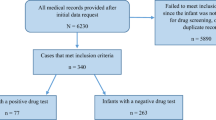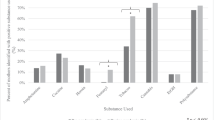Abstract
Objective:
The purpose of the study was to determine the neonatal illicit drug screening practices of Iowa birthing hospitals.
Study design:
Cross-sectional survey design was implemented. The impact of structured screening protocols on the numbers of neonates screened and positive testing in 2004 was reviewed.
Results:
Of 81 birthing hospitals, 53 (65%) participated in the study. Screening and positive test rates were higher in hospitals utilizing a structured screening protocol compared to those not utilizing one (10.9 versus 2.1% and 0.9 versus 0.2%, respectively, P<0.0001). Hospitals with higher population, numbers of outpatients, inpatients, deliveries, and availability of drug abuse treatment services utilized a structured screening protocol more often.
Conclusion:
Utilization of a structured screening protocol increases the number of neonates screened for illicit drugs and positive testing rate regardless of urbanization. Regional standardization of structured screening protocols may improve the recognition of perinatal illicit drug exposure and provision of treatment services.
This is a preview of subscription content, access via your institution
Access options
Subscribe to this journal
Receive 12 print issues and online access
$259.00 per year
only $21.58 per issue
Buy this article
- Purchase on Springer Link
- Instant access to full article PDF
Prices may be subject to local taxes which are calculated during checkout
Similar content being viewed by others
References
Bar-Oz B, Klein J, Karaskov T, Koren G . Comparison of meconium and neonatal hair analysis for detection of gestational exposure to drugs of abuse. Arch Dis Child Fetal Neonatal Ed 2003; 88: 98–100.
Hohman MM, Shillington AM, Baxter HG . A comparison of pregnant women presenting for alcohol and other drug treatment by CPS status. Child Abuse Negl 2003; 27 (2): 303–318.
Ostrea EM, Brady M, Gause S, Raymundo AL, Stevens M . Drug screening of newborns by meconium analysis: a large-scale, prospective, epidemiologic study. Pediatrics 1992; 89 (1): 107–113.
Eyler FD, Behnke M, Conlon M, Woods NS, Wobie K . Birth outcome from a prospective, matched study of prenatal crack/cocaine use: II. Interactive and dose effects on neurobehavioral assessment. Pediatrics 1998; 101 (2): 237–241.
Frohna JG, Lantz PM, Pollack H . Maternal substance abuse and infant health: policy options across the life course. Millbank Q 1999; 77 (4): 531–570.
Chasnoff IJ . Cocaine, pregnancy, and the growing child. Curr Probl Pediatr Adolesc Health Care 1992; 22 (7): 302–321.
Griffith DR . Prenatal exposure to cocaine and other drugs: developmental and educational prognoses. Phi Delta Kappan 1992; 9: 30–34.
Albert V, Klein D, Noble A, Zahand E, Holtby S . Identifying substance abusing delivering women: consequences for child maltreatment reports. Child Abuse Negl 2000; 24 (2): 173–183.
Zellman GL, Fair CC, Hoube J, Wong M . A search for guidance: examining prenatal substance exposure protocols. Matern Child Health J 2002; 6 (3): 205–212.
Arizona State Department of Public Health Practice Improvement Protocol 5. Substance use, abuse and/or dependence in pregnant and postpartum women. http://www.azdhs.gov/bhs/guidance/substance.pdf.
Washington State Department of Public Health Guidelines for screening substance abuse during pregnancy. http://www.doh.wa.gov/Publicat/Screening_Guidelines.pdf.
Indiana State Department of Public Health Newborn Meconium Screening Program. http://www.in.gov/isdh/programs/nbs/MecScrCriteria.htm.
Iowa Hospital Association. http://www.ihaonline.org/publications/profileserv/profileserv.shtml.
Ostrea EM, Knapp DK, Tannenbaum L, Ostrea AR, Romero A, Salari V et al. Estimates of illicit drug use during pregnancy by maternal interview, hair analysis, and meconium analysis. J Pediatr 2001; 138 (3): 344–348.
Appel PW, Hoffman JH, Blane HT, Frank B, Oldak R, Burke M . Comparison of self-report and hair analysis in detecting cocaine use in a homeless/transient sample. J Psychoactive Drugs 2001; 33 (1): 47–55.
Bibb KW, Stewart DL, Walker JR, Cook VD, Wagener RE . Drug screening in newborns and mothers using meconium samples, paired urine samples, and interviews. J Perinatol 1995; 15 (3): 199–202.
Sweeney PJ, Schwartz RM, Mattis NG, Vohr B . The effect of integrating substance abuse treatment with prenatal care on birth outcome. J Perinatol 2000; 4: 219–224.
Brown JV, Bakeman R, Coles CD, Platzman KA, Lynch ME . Prenatal cocaine exposure: a comparison of two year-old children in parental and nonparental care. Child Dev 2004; 75 (4): 1282–1295.
Berger L, Waldfogel J . Prenatal cocaine exposure: long-rung effects and policy implications. Soc Serv Rev 2000; 74 (1): 28–54.
El-Mohandes A, Herman AA, Nabil El-Khorazaty M, Katta PS, White D, Grylack L . Prenatal care reduces the impact of illicit drug use on perinatal outcomes. J Perinatol 2003; 23 (5): 354–360.
Little BB, Snell LM, Van Beveren TT, Crowell RB, Trayler S, Johnston WL . Treatment of substance abuse during pregnancy and infant outcome. Am J Perinatol 2003; 20 (5): 255–262.
Zellman GL, Bell RM, Archie C, DuPlessis H, Hoube J, Miu A . Physician response to prenatal substance exposure. Matern Child Health J 1999; 3 (1): 29–38.
Jaudes PK, Ekwo E, Van Voorhis J . Association of drug abuse and child abuse. Child Abuse Negl 1995; 19 (9): 1065–1075.
Easton S, Oral R . Factors associated with parental drug involvement in confirmed cases of child maltreatment. Proceedings of 19th San Diego Conference on Child maltreatment, San Diego, California, January 24–28 2005.
Locke TF, Newcomb M . Child maltreatment, parent alcohol and drug-related problems, polydrug problems, and parenting practices: a test of gender differences and four theoretical perspectives. J Fam Psychol 2004; 18 (1): 120–134.
Stein JA, Leslie MB, Nyamathi A . Relative contributions of parent substance use and childhood maltreatment to homelessness, depression, and substance abuse problems among homeless women: mediating roles of self-esteem and abuse in adulthood. Child Abuse Negl 2002; 26 (10): 1011–1027.
Walsh C, MacMillan HL, Jamieson E . The relationship between parental substance abuse and child maltreatment: findings from the Ontario Health Supplement. Child Abuse Negl 2003; 27 (12): 1409–1425.
Nair P, Schuler ME, Black MM, Kettinger L, Harrington D . Cumulative environmental risk in substance abusing women: early intervention, parenting stress, child abuse potential and child development. Child Abuse Negl 2003; 27 (9): 997–1017.
Azuma SD, Chasnoff IJ . Outcome of children prenatally exposed to cocaine and other drugs: a path analysis of three-year data. Pediatrics 1993; 92 (3): 396–402.
Chasnoff IJ, Anson A, Hatcher R, Stenson H, Iaukea K, Randolph LA . Prenatal exposure to cocaine and other drugs: outcome at four to six years. Ann NY Acad Sci 1998; 846: 314–328.
Van Dyke DC, Fox AA . Fetal drug exposure and its possible implications for learning in the preschool and school-age population. J Learn Disabil 1990; 23 (3): 160–163.
Tyler R, Howard J, Espinosa M, Doakes SS . Placement with substance-abusing mothers vs placement with other relatives: infant outcomes. Child Abuse Negl 1997; 21 (4): 337–349.
Oral R, Mueller R, Ahmed W . Prevalence of known risk factors for in-utero illicit drug exposure in mother–infant dyads admitted to UIHC for delivery in 2002–2003. Postgraduate Conference Proceedings, 23–24 September 2005, Iowa City, Iowa.
Kwong TC, Ryan RM . Detection of intrauterine illicit drug exposure by newborn testing. Clin Chem 1997; 43 (1): 235–242.
O’Connor TA, Bondurant HH, Siddiqui J . Targeted perinatal drug screening in a rural population. J Matern Fetal Neonatal Med 1997; 6 (2): 108–110.
Chasnoff IJ, Landress HJ, Barrett ME . Prevalence of illicit drug or alcohol use during pregnancy and discrepancies in mandatory reporting in Pinellas County, Florida. N Engl J Med 1990; 322 (17): 1202–1206.
Birchfield M, Scully J, Handler A . Perinatal screening for illicit drugs: policies in hospitals in a large metropolitan area. J Perinatol 1995; 15: 208–214.
Zellman GL, Jacobson PD, Bell RM . Influencing physician response to prenatal substance exposure through state legislation and work place policies. Addiction 1997; 92 (9): 1123–1131.
Ondersma SJ, Simpson SM, Brestan EV, Ward M . Prenatal drug exposure and social policy: the search for an appropriate response. Child Maltreat 2000; 5 (2): 93–108.
Adirim TA, Sen Gupta N . A national survey of state maternal and newborn drug testing and reporting policies. Public Health Rep 1991; 106 (3): 292–296.
Annas GJ . Testing poor pregnant patients for cocaine – physicians as police investigators. N Engl J Med 2001; 344 (22): 1729–1732.
Ondersma SJ, Malcoe LH, Simpson SM . Child protective services' response to prenatal drug exposure: results from a nationwide survey. Child Abuse Negl 2001; 25 (5): 657–668.
Acknowledgements
This study was made possible by a grant from Children's Miracle Network. The preliminary results were presented at the Fall Conference of Children's Hospital of Iowa 9/22-23/2005, Iowa City, IA.
Author information
Authors and Affiliations
Corresponding author
Rights and permissions
About this article
Cite this article
Oral, R., Strang, T. Neonatal illicit drug screening practices in Iowa: the impact of utilization of a structured screening protocol. J Perinatol 26, 660–666 (2006). https://doi.org/10.1038/sj.jp.7211601
Received:
Revised:
Accepted:
Published:
Issue Date:
DOI: https://doi.org/10.1038/sj.jp.7211601
Keywords
This article is cited by
-
Does adopting a prenatal substance use protocol reduce racial disparities in CPS reporting related to maternal drug use? A California case study
Journal of Perinatology (2015)
-
Retrospective analysis of the diagnostic yield of newborn drug testing
BMC Pregnancy and Childbirth (2014)
-
Universal Alcohol/Drug Screening in Prenatal Care: A Strategy for Reducing Racial Disparities? Questioning the Assumptions
Maternal and Child Health Journal (2011)
-
Applicability of non-invasively collected matrices for human biomonitoring
Environmental Health (2009)



